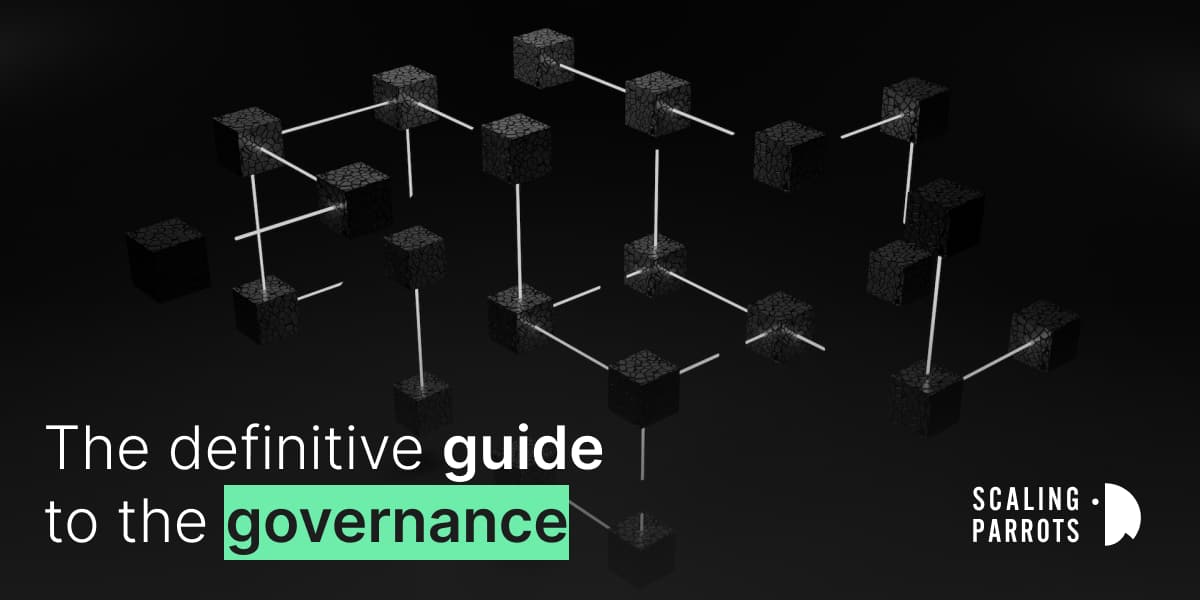
Blockchain has seen a wide variety of applications in our modern world, from cryptocurrency, the primary area of usage, to improving sustainability and even our everyday lives.
Blockchain has brought about profound changes in business and in its own nature. This technology has transformed how businesses are funded and managed, how they produce value, and even how fundamental operations like marketing and accounting are performed.
For a Blockchain to work accurately, it needs to be supervised or governed, and it gives rise to the topic of Blockchain governance.
Blockchain governance is a critical issue and has attracted attention primarily after the Ethereum DAO incident, in which a malicious agent used a software bug to channel nearly a third of the total value of the network into its account. However, the bug or issue was later fixed through a fork algorithm.
As the number of Blockchain projects grows, the question of governance systems becomes more prominent. Some platforms have included on-chain governance rules that are integrated into the platform’s main computer code, but others rely heavily on off-chain processes.
For some reading this article, the topic of Blockchain governance might sound new to you, and that’s why this article will explain what Blockchain governance is, how it works, and what it is used for.
What is Blockchain Governance?
Governance refers to decision-making procedures within an organization in matters such as who is accountable for what, how significant decisions are made or executed, whether authority is vested in a select few or dispersed among all participants, and so on.
These issues are critical to consider for an organization’s system operation. An effective governance model is what brings a company together. Logically, there is no ideal solution here; each model is situational, and its sustainability heavily depends on individual conditions.
While participatory democracy may work for some, having powers concentrated in a central authority may be desirable for others. Regardless of their differences, exceptional governance models are frequently based on a set of qualities: transparency, honesty, effective performance, and cooperation.
Blockchain governance generally refers to the power to change a Blockchain-based system. Alternatively, it may refer to social practices in which the user base of the public Blockchain decides or is persuaded, led, incentivized, or coerced, to jointly adopt certain changes to the Blockchain system, such as protocol updates that implement a hard fork.
These powers can be written into the software so that specific groups of people can make changes.
Blockchain governance involves the collection of processes and regulations that govern the platform’s essential operation, ownership, consensus method, prospective alterations, and future direction.
Governance rules are one of the core aspects of Blockchains and the protocols they operate on. Some have created governance tokens to separate transactional and governance operations on protocols. These tokens exist alongside the system’s primary transactional or utility token and are utilized during the official on-chain voting process.
One thing Blockchain governance does is that it uses Blockchain technology to build or exert authority over non-Blockchain social practices. One example is the real-world property registry chain, where no central authority controls the registration, and the registration status is jointly maintained.
How does Blockchain Governance work?
The primary principle of Blockchain operation is decentralization, which means eliminating gatekeepers or mediators in transactions to reduce costs and allowing participants to transact with each other directly using smart contracts.
On a broad scale, it entails eliminating centers of power like governments and their institutions, central banks, etc. Therefore Decentralized governance will be a natural response and a swift approach to the world’s ordeal that has been for centuries.
In this age where information is highly needed for personal empowerment and development, decentralization helps to drive toward a future design to vest authority and information in the hands of the people. For this reason, Blockchain governance is considered to be a digital extension of representative democracy.
Decentralized networks are often consensus-driven, allowing individuals to participate actively in the network and decision-making processes. Whenever a transaction is initiated, it requires the collective consent of interconnected nodes to proceed rather than that of a central operator.
What is Blockchain Governance for
- Blockchain governance makes it possible for there to be trust in the operation of the system. Trusting the codes is easy to accomplish because they will be tested publicly before implementation.
- Blockchain governance makes it possible for everything in the system to work seamlessly.
- Blockchain governance improves traceability, transparency, and traceability and significantly influences any industry that relies on supply chains.
- Blockchain governance institutes changes in the systems encoded into the Blockchain protocol mechanism.
Pillars of Blockchain Governance
- Blockchain team: The Blockchain team may be considered the Blockchain’s creators. They are responsible for managing the core code of a Blockchain. They are also in charge of other critical Blockchain areas like finance, marketing, etc. Depending on the sort of governance a certain Blockchain uses (on-chain or off-chain). This committee makes critical choices about the Blockchain’s future.
- Core developers: Core developers are in charge of maintaining the code that powers the Blockchain program. The core development team generally adds or deletes code that affects the product from a central code base. The core development team can make changes to the underlying code, but they can’t implement them since they don’t have control over the network. The operator in charge of the software node is responsible for implementing the update.
- Node operators: A node operator manages a computer that runs the full version of the Blockchain software and keeps a complete copy of the ledger. Node operators do, on the other hand, have the option of implementing code updates on their nodes. As a result, for Blockchain governance to function properly, core developers must incorporate code modifications that node operators agree to execute. It is analogous to the legislative and judicial roles. Lawmakers may propose new laws but not often create code; instead, they rely on core developers. The node operators serve as the judicial officer to decide whether or not it will be implemented.
- Token holders: Every user who owns a Blockchain’s token is a member of the chain’s token holder community. Various new and creative strategies are being employed by Blockchains nowadays to more efficiently solicit the opinions of their token holders while making decisions affecting the whole ecosystem.

Elements of Blockchain Governance
Consensus: For transactions to be confirmed on a Blockchain, some consensus mechanisms are used to verify its process. We have two primary consensus mechanisms: PoW (Proof-of-Work) and PoS (Proof-of-Stake). Bitcoin works on the PoW algorithm mechanism, while Ethereum 2.0 has upgraded from the previous PoW to the PoS model.
Incentives: An incentive is a medium used to reward a specific user’s behaviors on the network, which benefits a Blockchain’s overall development and smooth operation. Incentives in popular Blockchains are typically delivered in the form of their cryptocurrencies. They assist in inspiring more individuals to get involved with Blockchain, strengthening the ecosystem.
Information: The availability and amount of information on a particular Blockchain network play a significant role in Blockchain governance. For a Blockchain to be truly decentralized, maximum information must be present on the chain for easy user access. Better decisions can be made if uncensored information is available to the users of a Blockchain network.
Governing Structure: Unlike traditional governing systems, Blockchain governance is significantly more adaptable and can thus adapt to the requirements of its users much more efficiently.
Types of Blockchain Governance
Governance in Blockchains can be broadly classified into two categories:
- On-Chain Governance
- Off-Chain Governance
On-Chain Governance
On-chain governance refers to the process by which protocol upgrades occur automatically in response to token voting. In these systems, token holders directly vote on the corresponding measures using the network’s existing tokens.
The agreement will calculate the votes directly, and subsequent results will be carried out automatically. This relationship between token voting and code changes is often called “tight coupling”.
On-chain governance is still new when it comes to the governance of Blockchain, with some fascinating and unique concepts. So far, many of the on-chain governance concepts have either just launched or not yet launched.
On-chain governance solutions for Blockchains typically use on-chain voting methods tuned for that specific network to establish direct democracy.
On-chain governance is a decentralized governance model because it has the property of distributed decision-making, where nodes (different computers on the network) vote and make choices collaboratively rather than having one central authority in control.
On-chain payments for developers/nodes reward participation in voting procedures, but end users do not influence project management. Of course, the specifics of vote eligibility differ from project to project, but the essential feature remains a code-based voting mechanism for relevant stakeholders.
Aside from being decentralized, on-chain governance has the added benefit of quick decision-making, provided the concept is correctly implemented.
Because suggested modifications are imported into the project code, and developers are rewarded for voting, there is a sense of pressure to make improvements, especially when the system is supported by a voting and implementation deadline.
On-chain governance, on the other hand, may result in low voter turnout, particularly in the absence of an ideal reward structure for participating nodes. The issue is aggravated in such circumstances by the risk of undemocratic voting.
If some nodes choose not to vote, others with bigger coin holdings can determine the project’s future course. Overall, the system may pave the way for a compensation decision-making process in which ‘richer’ nodes might outnumber their ‘poorer’ counterparts via sheer force.
Examples of on-chain governance models are Tezos (XTZ) On-Chain Governance, EOS On-Chain Governance and Maker DAO Governance.
Off-Chain Governance
Off-chain governance refers to informal coordination between network stakeholders to decide how to handle network upgrades; most networks today use off-chain systems.
The most common process looks like this: developers submit changes through formal improvement proposals, network stakeholders coordinate through community channels (email forums and social media), protocol developers integrate new features, node operators agree or disagree with the changes, and miners decide which chain to maintain.
As you might expect, off-chain governance entails greater human engagement and limited code usage for decision-making. This can assist in eliminating code-based and data import errors in the context of Blockchain.
When making on-chain judgments, one must exercise considerable caution to avoid writing incorrect code; if they do, the network’s functioning is limited or non-functional by design.
As a result of Blockchain’s immutability, the human mistake aspect is considerably increased, making the off-chain governance paradigm far more useful for networks that make fewer overall choices. Likewise, it might theoretically give a more ‘expert’ view from the side with the most significant knowledge.
On the other hand, off-chain governance is frequently linked to transparency concerns. Because decisions can be taken behind closed doors and network constituents can only view the results, one may reasonably challenge the validity of decision-making procedures.
When this is combined with having a chosen few (typically in the form of a board) in charge of guiding the path of a project, you arrive at the first point of concern that led to Blockchain’s creation, removing central authority and vesting power in the network and all its members.
Examples of off-chain governance models are Bitcoin governance and Ethereum governance.
Advantages of Blockchain Governance
- Blockchain governance makes it possible for the network authority to be flexible, transparent and have integrity.
- Blockchain governance makes it possible for all nodes involved in a network to be notified and aware of any alteration in the system.

Disadvantages of Blockchain Governance
- First, it calls into question the interest of each user. All members have to have the same interest for the governing model to work seamlessly. However, this might not be the case in a large and disparate network.
- Second, Blockchains are still immutable even with a working deadline-induced voting system. Therefore, once any proposed changes are placed and verified, they cannot be rolled back.
- Also, achieving long-term sustainability requires a lot of time, effort, and expertise to develop a working governance model.
- Since the nodes and stakeholders might be anonymous, the network might argue against stakeholders’ credibility in representing the collective.
Conclusion
Blockchain governance is a constantly changing field. So far, the main Blockchains, Bitcoin and Ethereum, have performed admirably in the off-chain model. They have a strong online community that discusses all governance concerns, and their belief in such a model has not been shaken.
Many platforms using a mixed on-chain/off-chain format, such as Maker or Uniswap, have also handled their governance processes. It is important to note that the PoS algorithm is better equipped to handle voting practiced by on-chain Blockchain governance.
Purely on-chain governed platforms, such as Tezos and EOS, have seen limited adoption and, therefore, are yet to be thoroughly tested against the key danger of the strictly on-chain format – power usurpation by a limited group of users.
If these networks gain wider use, their governance models will have a chance to either silence the critics or admit their shortcomings.
It will likely take years to determine if on-chain governance, off-chain governance, or integrating both governance models will finally be more important. Over that period, there will undoubtedly be some ground-breaking technological breakthroughs and changing governance frameworks to accommodate the new paradigm of the decentralized Internet.
See you soon,
Scaling Parrots
